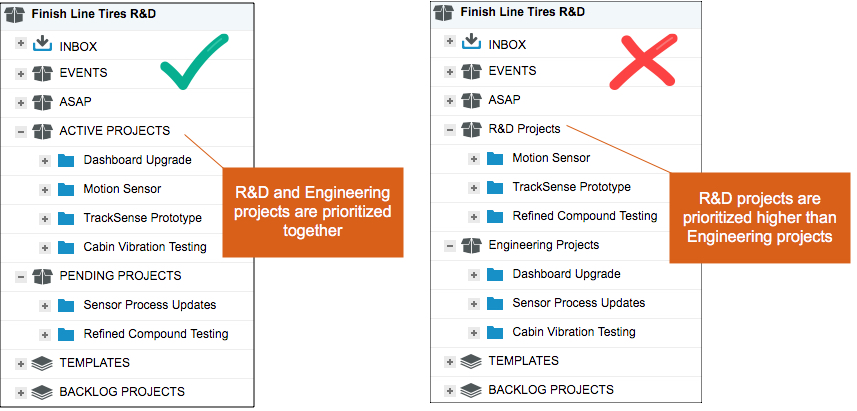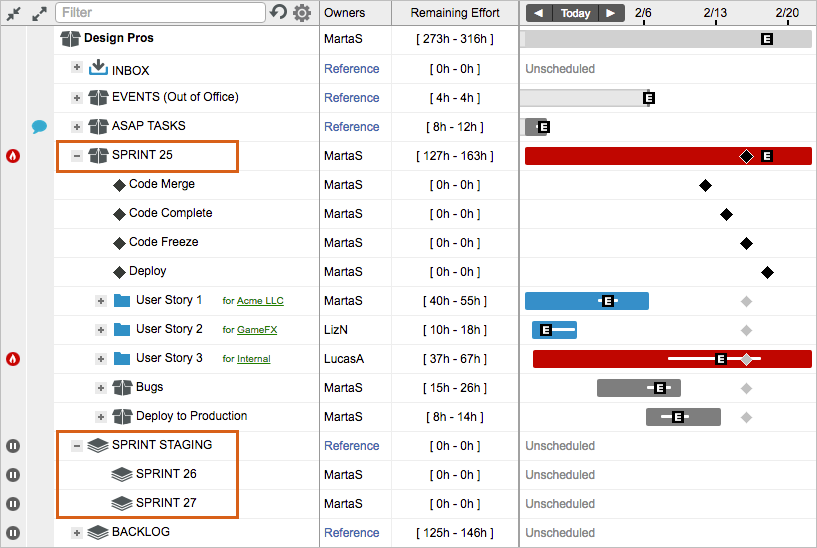
![]() LiquidPlanner uses an item called Packages to help you prioritize your work in two ways:
LiquidPlanner uses an item called Packages to help you prioritize your work in two ways:
- Prioritize your workflow. For example: the Active Projects package is prioritized higher than Pending Projects. Or a 2019 Projects package is prioritized above a 2020 Projects package.
- Prioritize individual tasks from low priority projects (to learn more read about the ASAP package)
Packages are also subject to LiquidPlanner’s “top-to-bottom” priority-based methodology. This article will introduce you to the most common package structure that can help you prioritize your projects and tasks.
Using packages to organize projects by categories (ex: by department or project type) can negatively affect your priorities. Read further learn about the potential pitfalls, and what features you can use instead.
Status Model Package Structure
The Status Model is the most common package configuration because it provides quick visibility into active vs. pending projects. This model also naturally reinforces listing projects in priority order from top-to-bottom, which is a key aspect of LiquidPlanner’s priority-based scheduling methodology.

Inbox
The Inbox is at the top of every workspace and can be used as part of your project intake process. Items in the Inbox are unscheduled, so you can build out new tasks that need review prior to being scheduled and prioritized in your plan.
Events
Keep the events your team is using to block time out of the schedule for meetings, holidays, and vacations in this package. Unlike tasks, events will always be scheduled for the date and time that you set, regardless of where they’re placed in the plan hierarchy. We recommend keeping PTO grouped together in the Events package so it’s easy to see who is out of the office.
ASAP
LiquidPlanner’s priority-based scheduling methodology will schedule your tasks in order from top to bottom by default, but sometimes tasks from projects listed lower in the workspace will need to be done before tasks listed higher up in the workspace. Use the ASAP package to manage your to-do list. Package up tasks from multiple concurrent projects to schedule them in the order they need to be completed.
Active Projects
Keep the projects your team is actively working on in a package called “Active Projects”. Be sure to list them in priority order so LiquidPlanner schedules them accordingly.
Pending Projects
This is where you’ll keep any projects that have not started yet, or perhaps the project is still being scoped. You can rename this to “Planned Projects” or “Awaiting Approval”. Pending Projects is placed below the Active Projects packages so that LiquidPlanner schedules all tasks assigned in the Active Projects package first. You can also keep the Pending Projects package On-Hold.
Templates
If you have projects with the same tasks and phases, create a template version of those projects and keep them in the Templates package. When a new project is approved, just duplicate the template, drag and drop it to the appropriate place in the plan.
Avoid Category Packages
It can be natural to use Packages to categorize your projects by team or project type, but it is not recommended. Since Packages must also be placed in top-to-bottom priority order, setting up packages by category will result in your highest priority projects being inaccurate.
In the example below, the package structure organizes projects by Team Category. Notice that the R&D projects are prioritized above the Engineering package. This is problematic if you have shared resources working on projects across both teams. LiquidPlanner will assume team members should work on their R&D projects first, before working on their Engineering projects below.

Sprint Package Structure
If you’re an Agile team, you can configure your workspace using our sprint package structure.

Time Based Structure
You can also set up packages to organize your project workflow in time-based packages. For example, prioritizing your projects quarter-by-quarter or year-to-year.

Next: Add your Custom Project Data
Once you’ve established your workspace package structure, you’re projects and packages should reflect the priority of work for your team.
The next step in setting up your new workspace is configuring your workspace settings to capture key data about your projects using custom fields, activities, teams, and more.
3. Customize Data » « 1. Create First Project

